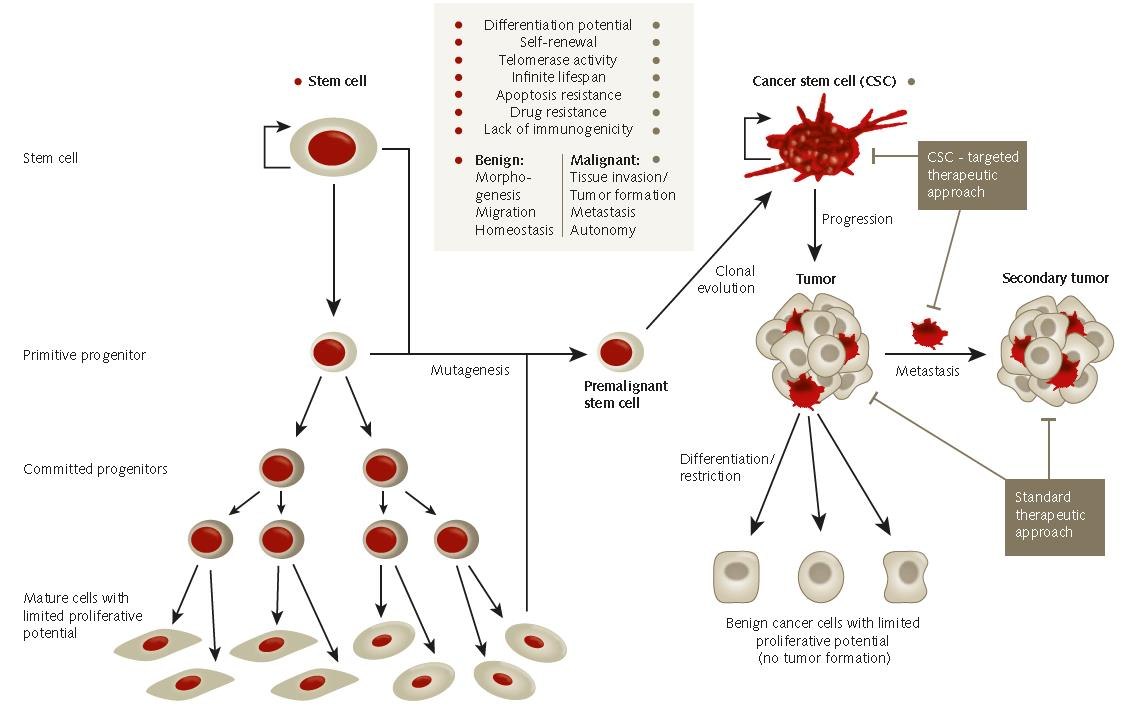Tumor Spheroid Formation Assay
Cancer research is one of today’s major research fields producing thousands of publications every year. Traditional therapeutic approaches aim to eliminate as much of the tumor mass as possible by means of surgery, irradiation, chemotherapy and biologics. However, evidence suggests that these techniques do not target the root of the disease: the cancer stem cell (CSC) subpopulation within the tumor.1 Cancer stem cells have been identified in various cancers including hematopoietic and many solid tumors.5 CSCs are defined as a small subset of malignant cells within the tumor with the exclusive ability to self-renew and maintain stem cell properties. They can differentiate into a heterogeneous mass of both non-tumorigenic and tumorigenic cell types and evade traditional chemotherapy and lead to cancer regression and metastasis.3
The gold standard functional in vivo assay for CSCs is the serial transplantation of isolated single cancer cells into immunocompromised mice (i.e. NOD SCID mouse). However, this method requires lengthy protocols and results are often difficult to interpret. The in vitro spheroid formation assay includes methods to generate colony-forming units (CFUs) in both semi-solid media and as 3D tumorsphere aggregates. The tumorsphere formation efficiency (TFE assay) indicates the percentage of cells within a cancer cell culture that are capable of forming a sphere from a single cell. TFE values are a quantitative measurement to measure the amount of cancer stem cells within a tumor/cancer cell line and is correlated with cancer metastasis and aggressiveness.
The PromoCell 3D Tumorsphere Media XF (C-28070, C-28075) is designed to serially passage cancer stem cells as undifferentiated 3D tumospheres with high cell proliferation rates. It’s defined and serum-free formualtion allows consistent and standardized expansion of sphereoids while maintaining the cancer stem cell characteristics such as self-renewal and chemoresistance. The media has been shown to support spheroid cell cultures from the following cell lines: U-87 MG, MCF-7, MDA-MB-231, HT-29, HT1080, HepG2, A549, Panc-1, LNCaP and A431.

Figure 1.The cancer stem cell hypothesis. The in vitro spheroid formation assay is a common assay used to measure the self-renewal and multipotent nature of the cancer stem cell subpopulations within a tumor or cancer cell line.
Spheroid Formation Assay Protocol

Figure 2.Overview of the spheroid formation assay protocol.
- Collect the tumorspheres. Transfer the tumorspheres into a 15 mL conical tube.
- . Allow the spheres to settle by gravity sedimaentation for 10 minutes at room temperature. Aspirate the supernantant but leave approximately 200 µL in the conical tube. Do not aspirate tumorspheres.
- Wash the tumorspheres. Repeat Gravity sedimentation of tumorspheresstep two with an equal volume of PBS (D8537). Gently asirate the PBS and leave 200 µL in the conical tube.
- Enzymatic digest the tumorspheres. Add 1 mL of Trypsin-EDTA (T3924) to the tumorspheres and incubate for 2-4 minutes at room temperatrue. Pipet up and down every 30 seconds to avoid sedimentation. Some cells require a longer incubation period.
- Break apart the tumorspheres. Pipet up and down 10-20 times using a p-1000 to achieve a single cell suspension. Add twice the volume of Trypsin Neutralization Solution (T6414).
- Determine cell viability. Make up 5 mL with fresh 3D Tumorsphere Medium XF (C-28070, C-28075) and determine the cell number and viability. Centrifuge cells for 5 minutes at 300 x g. Pass cells through a 40 µm cell stariner to obtain a single-cell suspension then determine the cell count.
- Dilute the single cell suspension. Dilute an aliquot of the single-cell suspension in fresh media to achieve 10 viable cells/mL (prepare at least 50 mL of media).
- Plate single cells (day 0). Distribute 100 µL of single cell suspension from step 7 into each well of a 96-well u-bottom plate. Seed 3-5 entire plates.
- Let the tumorspheres grow. Incubate the plates in the incubator at 37 °C and 5% CO2.
- Add fresh medium (day 4-6). On day 4-6 add 100 µL of fresh media to each well. Do not change media, only add to the existing media.
- Evaluate (day 7-12). Check the wells of the 96 well plate for sphere formation. Count the number of spheres and divide by the total nuber of wells seeded and then multiply by 100 to determine the TFE.
Note: It is recommended to use the mean diameter of the cell aggregate as a readout parameter using a microscopre grid or ruler. Ideally, the median sphere diameter of a specific cell line is allready known from previous experiments. For example, MCF-7 cells exhibit a mean diameter of > 150 µM after 10-12 days. Aggregates with < 80 µM should never be counted as positive. Some slowly growing cell lines require more than 7-12 day growth to achieve large enough spheroids to quantify.
Results

Figure 3.Expected results from an in vitro spheroid formation assay. A) Positive tumorsphere derived from a single MCF-7 cell larger than the 150 µm cutoff size. B) Negative tumorsphere derived from a single MCF-7 cell smaller than the 150 µm cutoff size.

Figure 4.Tumorsphere culture of MCF-7 breast cancer cells in the PromoCell 3D Tumorsphere Media XF after 10 passages. The tumorsphere culture was subject to serial passage every 9 days by enzymatic dissociation according to the protocol. Robust tumorsphere formation was maintained during serial culture
Materials
References
To continue reading please sign in or create an account.
Don't Have An Account?